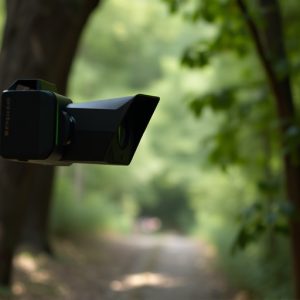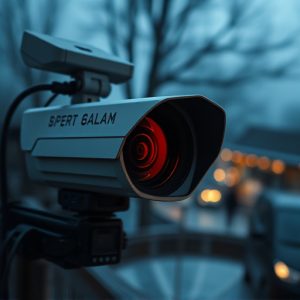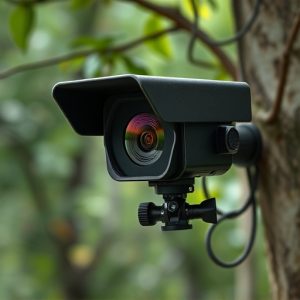Unveiling Hidden Mini Spy Cameras: Nighttime Scanning & Advanced Detection Methods
Mini spy cameras have evolved with advanced nighttime recording capabilities, utilizing infrared tec…….
Mini spy cameras have evolved with advanced nighttime recording capabilities, utilizing infrared technology and signal scanning algorithms to capture high-quality video in complete darkness. These devices are ideal for 24/7 surveillance but raise legal and ethical concerns regarding privacy. Professionals use thermal imaging and RF analysis for accurate detection, while modern signal processing algorithms can identify hidden cameras by analyzing video feeds. Machine learning models enhance accuracy, especially under low-resolution conditions. Balancing security and individual freedoms is crucial; ethical usage requires consent or adherence to legal boundaries.
Uncover the unseen with our guide to hidden recording device signal scanning methods. Mini spy cameras, often imperceptible, pose significant privacy risks, especially during nighttime recordings. We explore advanced techniques like signal scanning to detect these invisible intruders. From understanding mini spy camera capabilities to legal and ethical considerations, this comprehensive article equips you with knowledge to protect against clandestine surveillance. Learn how to navigate the intricate world of nighttime recording and defend your privacy.
- Understanding Mini Spy Cameras and Their Capabilities
- Nighttime Recording Techniques: Uncovering Hidden Devices
- Signal Scanning Methods: Detecting Invisible Cameras
- Advanced Technologies for Spy Camera Identification
- Legal and Ethical Considerations in Signal Scanning
Understanding Mini Spy Cameras and Their Capabilities
Mini spy cameras, also known as hidden recording devices, have evolved significantly, offering advanced capabilities in a compact form factor. These tiny yet powerful tools are designed to capture high-quality video and still images discreetly, making them ideal for various purposes, from home security to professional surveillance. One of their standout features is the ability to perform nighttime recordings, where low-light conditions can be challenging for regular cameras.
Equipped with advanced sensors and infrared technology, mini spy cameras can produce clear footage even in complete darkness. This capability is particularly useful for monitoring activities that occur after hours, ensuring round-the-clock observation without compromising on picture quality. Whether it’s a home security system or a business’s surveillance setup, these miniature cameras provide a discrete and effective solution, allowing users to stay informed and protected 24/7.
Nighttime Recording Techniques: Uncovering Hidden Devices
In the realm of mini spy cameras and nighttime recording, specialized techniques are employed to uncover hidden devices. One effective method involves using advanced signal scanning tools that can detect even faint electromagnetic signatures emitted by these covert devices. During nocturnal operations, when visual observation is limited, professionals rely on infrared (IR) technology to capture heat signatures, which can reveal the presence of hidden cameras or listening devices.
By integrating thermal imaging with radio frequency (RF) signal analysis, investigators enhance their chances of detecting clandestine surveillance equipment. Nighttime recording techniques are particularly crucial in scenarios where privacy is a paramount concern, such as in high-security areas or during sensitive investigations. This blend of technology ensures that no hidden device goes unnoticed, providing a robust layer of protection against unauthorized monitoring.
Signal Scanning Methods: Detecting Invisible Cameras
In the realm of hidden recording devices, particularly mini spy cameras designed for nighttime recordings, signal scanning methods play a pivotal role in detecting their presence. Traditional techniques often rely on visual inspection or specific software that can uncover these concealed devices by analyzing video feeds for unusual patterns or artifacts. However, as technology advances, so do the capabilities and concealment of such cameras, necessitating more sophisticated approaches.
One cutting-edge method involves utilizing advanced signal processing algorithms to scan through various frequency bands where mini spy cameras operate discreetly. By mimicking natural light conditions during nighttime recording attempts, these algorithms can reveal the subtle electronic signatures left by hidden cameras. This approach is particularly effective in high-resolution video analysis, enabling users to uncover even the most sophisticated and elusive miniature spy cameras.
Advanced Technologies for Spy Camera Identification
The evolution of technology has given rise to sophisticated methods for identifying hidden recording devices, particularly mini spy cameras that are adept at capturing nighttime recordings. Advanced image processing algorithms play a pivotal role in this process. These algorithms can analyze video feeds and detect subtle anomalies, such as irregular patterns or artifacts that might indicate the presence of a hidden camera. Machine learning models, trained on vast datasets of known spy camera signatures, have shown remarkable accuracy in identifying these devices, even when they operate at low resolution or during nighttime conditions.
Additionally, thermal imaging technology offers a unique perspective in the hunt for mini spy cameras. Heat signatures can reveal invisible to the naked eye differences between regular objects and hidden recording devices, making it an effective tool for detecting clandestine surveillance equipment. This non-intrusive approach allows professionals to uncover hidden cameras without alerting the perpetrators, ensuring privacy and security in various settings, from homes and offices to public spaces.
Legal and Ethical Considerations in Signal Scanning
The use of hidden recording devices and signal scanning methods raises significant legal and ethical concerns, especially when targeting individuals or areas without explicit consent. In many jurisdictions, the installation and operation of surveillance equipment are governed by strict privacy laws. Using mini spy cameras for nighttime recording without authorization can constitute a breach of privacy rights, leading to severe legal repercussions.
Ethically, signal scanning practices must consider the balance between security needs and individual freedoms. It is essential to obtain consent or operate within clear legal boundaries, such as in cases of public safety monitoring or authorized investigations. Unethical use of hidden recording devices can foster a culture of distrust and invade personal spaces, necessitating transparent policies and guidelines for their deployment.
In conclusion, the ability to detect hidden mini spy cameras has evolved significantly through advanced signal scanning methods, particularly during nighttime recording. These techniques, combined with modern technologies, empower individuals and organizations to protect privacy and security. However, it’s crucial to navigate legal and ethical boundaries while utilizing these powerful tools, ensuring responsible and lawful application in the ever-changing digital landscape.


